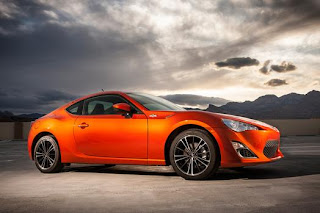I spent a fun week with a Hot Lava orange model with a six-speed manual transmission. This car delivers the goods, with taut handling, a short-throw transmission with the metal-on-metal precision of a Miata, and the low-slung, quick feeling you want in a car built for driving pleasure.
FR-S stands for Front-engine, Rear-wheel drive, Sport. I still am not a big fan of acronymic car names, especially new ones. The Subaru is called the BRZ. I have no idea what that stands for. In my opinion, this is a car that just screams to be called a Toyota Celica, but Toyota is giving this to Scion as a "halo car." The brand needs more fresh products, too.
There are Toyota historical references. The company directs us back to the beloved "hachi-roku" (8-6 in Japanese) AE86 Corolla, which offered sparkling performance at a reasonable price point. They even installed a surprisingly weighty-looking "86" chrome badge on the front fenders that combines the "hachi-roku" with a horizontal piston, indicating the flat, horizontally-opposed engine (a Subaru specialty). This is the first use of this type of engine in a front engine, rear-wheel-drive configuration.
Although Subaru was the main engine developer, Toyota added its special touch. Their D-4S injection system incorporates both direct and port injection for each cylinder, one injecting fuel directly into the combustion chamber, the other a port injector located above the intake valves. Both cars share this technology, and it means that they get 200 horsepower and 151 lb.-ft. of torque from just 2.0 liters of displacement, without a turbocharger. However, like turbo models, the engine uses premium fuel, which at last report from my local 76 station (not related to 86) was running a sobering $4.41 a gallon. I got 26.9 mpg, and the EPA awards the car 22 City, 30 Highway, and 25 Average.
I took the car on my normal errands, but also swung by Palomares Road, a slithering stretch of north-south two-lane not too far from home. As I expected, the FR-S stayed stable in various radius turns, leaped forward in the short sections of straightaway, the steering was responsive and in the narrow sport seats, it was all grins for me. I kept it in second and third gear the whole time, and didn't need to hit anywhere near triple digits to have a blast.
 |
| FR-S inspired by Toyota 2000GT (left) |
The interior is appropriately proportioned, and, as a Scion, isn't lavish. The "turned plastic" dash panel looked cheap, but the overall presentation felt strong and fairly upscale. The leather shifter and steering wheel (which tilts and telescopes) make the proper reference to the car's classic British inspirations. The pistol-grip door pull and armrest felt just right when I wasn't busy steering and shifting. The dash cover looks "melted" over the speaker grilles -- a cute touch.
The FR-S comes standard with an eight-speaker AM/FM/CD/USB 300-watt Pioneer audio system. Standard features also include HD Radio™ technology and Bluetooth® connectivity. I was able to set up my phone and plug in my iPod with no problem.
You really do sit low in this car, and it's hard to drop down into the seat and spring up quickly when you exit if you're not in the blush of youth. I also felt the seatbelt touching my neck, and there is no way to adjust it--the strap it ran through on the seat made no difference. Once you're in place, though, it's cozy and not too rough on the old posterior.
There's a vestigial back seat in the car, distinguishing it from a Miata, but it's best to flip it down and use its flat surface to carry stuff. This is a trunked coupe--not a hatchback.
Pricing starts at $24,930 for the six-speed manual and $26,030 for the automatic. That puts it at the top of the Scion hierarchy, where a halo car belongs. Despite its legitimate chops as a sports coupe, it seems a bit off-target from the basic cars on the original Scion mission--but I doubt if there is any complaining from car shoppers or Toyota and Subaru dealers.













